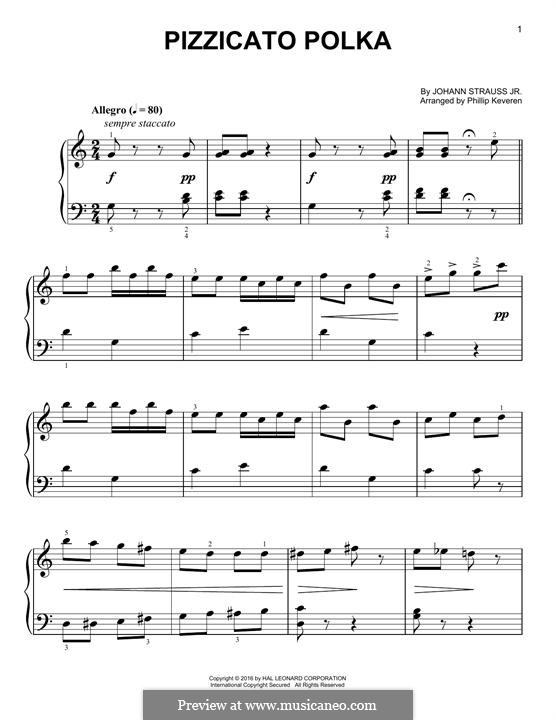

Recently however, he began to feel that the high registers of (especially) the first cello were not of optimum sonority for cello in pizzicato, so in 2017 he has slightly changed the playing registers, particularly in the central (trio) section. There it stood unchanged for over two decades although performed in many different countries by different cello ensembles.

The piece, as the title indicates, is scored for plucked (pizzicato) strings.ĭavid Johnstone first arranged this for four cellos in his mid-2os for the London-based group ‘The Cello Company’. The piece consists of four fragments of melodies and the work is arranged in ternary form (A-B-A). It was hugely popular from the outset, especially in Italy, where it was always included on every programme Strauss played there. The polka was written for string orchestra and glockenspiel, though percussion is often omitted today as it solely appears for the first half of the central section. Johann Strauss II composed it with his brother Josef in 1869 for a trip to Russia. “Pizzicato Polka” is a very popular piece of orchestral music. General difficulty of the music – other brief Information: The tempo indication is – Allegro giocoso
Pizzicato polka string orchestra pdf#
PDF 1 – All individual cello parts (14 pages in all) Also with the possibility of being rehearsed/performed by Cello Orchestra / use in the Cello class etc. – Pizzicato Polka – this music has been specially produced for Four Cellos. Johann Strauss wrote a Pizzicato Polka and in the 20th century Britten wrote a whole movement for pizzicato strings in his Simple Symphony.Johnstone Creations – JOHANN STRAUSS J and J. Tchaikovsky’s Symphony no 4 has a whole scherzo movement for pizzicato strings. In the 19th century the Romantic composers often asked for pizzicato. Monteverdi used it in his opera Il combattimento di Tancredi e Clorinda. In orchestras composers used pizzicato in the 17th century. This is not the same as jazz bass players who slap the strings at the end of a note (“slap bass”). One special effect can be made by pulling the string hard and letting it go so that it snaps against the fingerboard. Double basses usually play pizzicato when playing with jazz groups. For example: in a waltz the cellos and violas might be accompanying the tune with an “um-cha-cha, um-cha-cha” while the double basses just pluck on the “um” (the first beat of the bar). Double basses often play pizzicato to give extra rhythmic and harmonic support. Pizzicato notes on the double bass sound much more resonant (big and boomy). The player can get different sounds by plucking in different parts of the string. Pizzicato notes sound short and detached (staccato). This is fine so long as the player has time to pick the bow up again when it goes back to arco. If there is a long pizzicato section then it is more comfortable to put the bow down instead of holding it in the right hand all the time. It can take a little more time to go back to bowing again because the player has to get the bow back into playing position. If the bowed note finishes near the tip the player needs a moment to get the hand ready to pluck. It is easy to play a bowed note and then immediately a plucked note if the bowed note finished near the heel of the bow (the end where the bow is held). Very often players have to change very quickly from bowing to plucking and back again. This is normally when they are deliberately imitating a guitar. Very occasionally violinists may be asked to pluck their instruments holding them down in their laps. Stopped strings are harder, and the brilliant violinist and composer Niccolò Paganini wrote some virtuoso pieces with extremely difficult left hand pizzicato. It is not difficult to pluck an open string with the left hand. It is also possible to play pizzicato with the left hand (the hand which is normally doing the fingering). Cellists and double bass players can use the thumb for plucking, especially for playing chords.

Sometimes more fingers can be used for particularly fast pizzicato sections. Sometimes the player may rest the thumb on the edge of the fingerboard to keep the hand steady. Bassists typically use the index and middle finger. When instruments of the violin family are played pizzicato the player usually plucks the string with the index finger (pointing finger) of the right hand somewhere over the fingerboard. When the player has to play with the bow again the word “arco” is written in the music (“arco” is the Italian word for “bow”). Instruments such as the violin, viola, cello and double bass are normally played with a bow, but if the composer wants the player to pluck instead of bow, the word “pizzicato” or just “pizz” is written in the music. Pizzicato means: playing a string instrument by plucking the strings (pulling a string with the finger and letting go quickly).


 0 kommentar(er)
0 kommentar(er)
